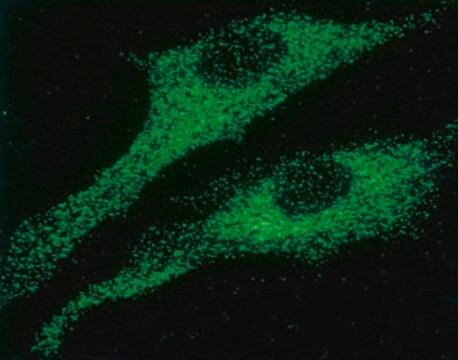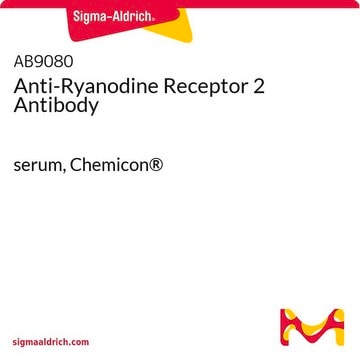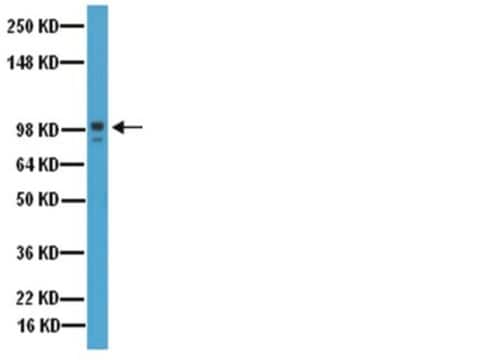推荐产品
一般描述
海肾萤光素酶是一种单体生物发光蛋白,来源于海肾(Renilla reniformis)。 在基因表达或相互作用的研究中,海肾荧光素酶常用作报告基因。36 kDa的酶催化底物腔肠素氧化为腔肠酰胺,从而产生可见光。海肾萤光素酶与萤火虫(Photalis pyralis)荧光素酶不同,识别的底物也不同,因此两种酶可以同时用于同一试验。
特异性
海肾萤光素酶
免疫原
海肾萤光素酶GST融合蛋白
应用
可使用这种海肾萤光素酶抗体(克隆5B11.2)检测海肾萤光素酶,该抗体经验证可用于ELISA、FUNC、NEUT & WB。
研究子类别
表位标签
表位标签
研究类别
表位标签 & 一般用途
表位标签 & 一般用途
蛋白质印迹:
先前批次的抗体已用于WB。
EIA:
先前批次的抗体已用于ELISA。
中和:
先前批次的抗体已用于NEAT。
最佳工作稀释度必须由最终用户确定。
先前批次的抗体已用于WB。
EIA:
先前批次的抗体已用于ELISA。
中和:
先前批次的抗体已用于NEAT。
最佳工作稀释度必须由最终用户确定。
目标描述
36 kDa
外形
小鼠单克隆IgG1腹水。
未纯化
储存及稳定性
自收到之日起,以未稀释的等分试样形式可于-20ºC条件下稳定保存1年。
处理建议:收到后,在取下瓶盖之前,将小瓶离心并轻轻混合溶液。分装到微量离心管中,并储存于-20°C。避免反复冻融循环,以免损坏IgG和影响产品性能。
处理建议:收到后,在取下瓶盖之前,将小瓶离心并轻轻混合溶液。分装到微量离心管中,并储存于-20°C。避免反复冻融循环,以免损坏IgG和影响产品性能。
分析说明
对照
海肾
海肾
其他说明
浓度:请参考批次特异性浓缩物的检验报告。
法律信息
CHEMICON is a registered trademark of Merck KGaA, Darmstadt, Germany
免责声明
除非我们的产品目录或产品附带的其他公司文档另有说明,否则我们的产品仅供研究使用,不得用于任何其他目的,包括但不限于未经授权的商业用途、体外诊断用途、离体或体内治疗用途或任何类型的消费或应用于人类或动物。
未找到合适的产品?
试试我们的产品选型工具.
储存分类代码
11 - Combustible Solids
WGK
WGK 1
闪点(°F)
Not applicable
闪点(°C)
Not applicable
Jaume Lillo et al.
International journal of molecular sciences, 22(16) (2021-08-28)
Cannabinoids have been reported as orexigenic, i.e., as promoting food intake that, among others, is controlled by the so-called "hunger" hormone, ghrelin. The aim of this paper was to look for functional and/or molecular interactions between ghrelin GHSR1a and cannabinoid
Maija Pollari et al.
PLoS pathogens, 16(10), e1008965-e1008965 (2020-10-09)
In this study, we demonstrate a novel pro-viral role for the Nicotiana benthamiana ARGONAUTE 1 (AGO1) in potyvirus infection. AGO1 strongly enhanced potato virus A (PVA) particle production and benefited the infection when supplied in excess. We subsequently identified the
Replication competent molecular clones of HIV-1 expressing Renilla luciferase facilitate the analysis of antibody inhibition in PBMC.
Edmonds, TG; Ding, H; Yuan, X; Wei, Q; Smith, KS; Conway, JA; Wieczorek, L; Brown et al.
Virology null
Mickaël Bouvet et al.
The Journal of biological chemistry, 289(37), 25783-25796 (2014-07-31)
The RNA-synthesizing machinery of the severe acute respiratory syndrome Coronavirus (SARS-CoV) is composed of 16 non-structural proteins (nsp1-16) encoded by ORF1a/1b. The 148-amino acid nsp10 subunit contains two zinc fingers and is known to interact with both nsp14 and nsp16
Rafael Franco et al.
Cells, 9(5) (2020-05-03)
(1) Background. N-methyl d-aspartate (NMDA) ionotropic glutamate receptor (NMDAR), which is one of the main targets to combat Alzheimer's disease (AD), is expressed in both neurons and glial cells. The aim of this paper was to assess whether the adenosine
我们的科学家团队拥有各种研究领域经验,包括生命科学、材料科学、化学合成、色谱、分析及许多其他领域.
联系技术服务部门








